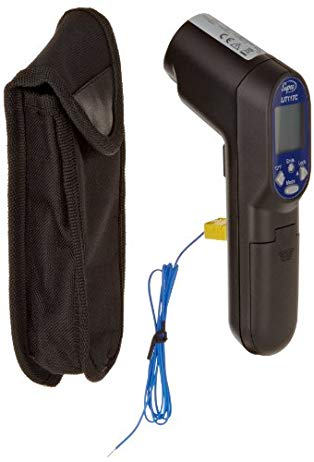The Supco LIT11TC infrared thermometer with K-type thermocouple probe is for measuring temperature in heating, ventilation, and air conditioning applications, including refrigeration and heating systems, supply and return registers, circuit breaker panels, motors and bearings, transformers, and ducts. When taking infrared measurements, the thermometer measures temperature from -60 to 500 degrees C (-76 to 932 degrees F) with a best accuracy of + or – 1 degree C (+ or – 2 degrees F). The Infrared sensor measures temperature from a distance for applications involving hard-to-reach, moving, hot, or electrified equipment. The detachable K-type thermocouple probe takes contact surface temperature measurements. The infrared sensor has an 11:1 distance-to-spot ratio, which means the measurement field measures approximately 11 feet in diameter when the target is 1 foot away. It has an adjustable emissivity setting to help improve measurement accuracy on a range of surface types. A built-in laser pointer helps improve aiming accuracy when taking infrared measurements. The LCD screen can display the current temperature, the highest or lowest temperature reading for the session, the difference between the high and low temperatures, and the average temperature for the session. The operator can choose to display readings in degrees Fahrenheit or Celsius. The operator can set high and low temperature alarms to sound when measurements exceed or drop below the preset limits. The display is backlit for readability in low light. The thermometer operates on two AAA batteries (included), and it can be set to automatically shut off after 60 seconds or 12 minutes of non-use to conserve battery life. A carrying case is included for transporting and storing the thermometer.
Specifications
| Infrared thermometer temperature measurement range | -60 to 500 degrees C (-76 to 932 degrees F) |
| Infrared thermometer accuracy (measuring 59 to 95 degrees F at ambient temperature of 77 degrees F) | + or – 1 degree C (+ or – 2 degrees F) |
| Infrared thermometer accuracy (measuring -14.8 to 391.8 degrees F) | + or – 2% of reading, or 4 degrees F (whichever is greater) |
| K-type thermocouple temperature measurement range | -64 to 1400 degrees C (-83.2 to 1999 degrees F) |
| K-type thermocouple accuracy | + or – 1% of reading, or 2 degrees F |
| Probe temperature measurement range | 14 to 250 degrees C (58 to 482 degrees F) |
| Resolution | 0.1 degree F |
| Distance-to-spot ratio | 11:1 |
| Emissivity range | 0.10 to 1, adjustable |
| Response time | 1 second |
| TPI wavelength | 8 to 14 nanometers |
| Operating temperature | 0 to 50 degrees C (32 to 122 degrees F) |
| Power supply | AAA batteries (two, included) |
| Weight | 179 g (6.3 oz.) |
| Dimensions* | 175 x 39 x 71.9 mm/6.9 x 1.5 x 2.8 in. (H x W x D) |
*H is height, the vertical distance from the lowest to highest point; W is width, the horizontal distance from left to right; D is depth, the horizontal distance from front to back.
Digital infrared thermometers measure the temperature of surfaces from a distance. They may measure temperature in Celsius, Fahrenheit, or both. Infrared (IR) thermometers work by focusing the infrared radiation emitted by a surface onto a detector called a thermopile. The thermopile turns the heat into electricity, which is measured and converted to a temperature reading. The reading is then displayed on an LCD display. IR thermometers are used to measure temperature when an object is fragile, as in ear thermometers, or dangerous to be near, as in the case of industrial equipment.
Supco manufactures test instruments and replacement parts for heating, ventilation, air conditioning, and refrigeration systems. The company, founded in 1945, is headquartered in Allenwood, NJ.
What’s in the Box?
- Supco LIT11TC infrared thermometer
- K-type thermocouple probe
- (2) AAA batteries
- Carrying case
- Instructions
Industrial & Scientific / Measure & Inspect / Supco / Temperature & Humidity / Test

